West Virginia University
in Vendée, France

"The Fool on the Hill..."
June 23, 1998
Thanks for your patience, heavy images today. ML
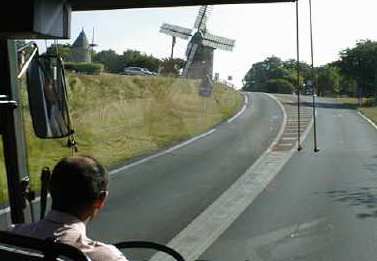
"Le Puy du Fou" literally means "the Mountain of the Fool",
but poetic license would certainly allow my free translation of "Fool on the
Hill". Above we see the windmill on the road as we approach one of the most
famous parks in France. Unlike many American theme parks, however, this one has no
rides at all. Everything here is a study of the deep culture of Vendée and France
through the ages.
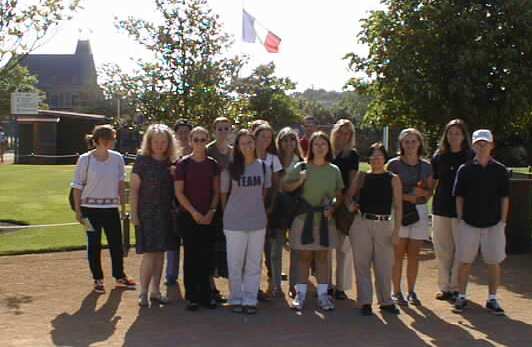
Inside the park, some of our WVU-Vendéens pose on the bridge leading into the
different worlds of time we are about to explore.
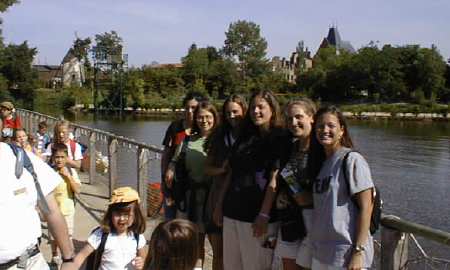
The site of Le Puy du Fou was originally famous as the scene of one of the
firey battles of the Wars of Vendée, back in the 1790's, when the region rose up against
the French Revolution in fidelity to "God and King". The Renaissance
château in the background behind our WVU-Vendéens is now in ruins, but is serves as the
background to a spectacular midnight re-enactment of the Vendée Wars that draws tens of
thousands of French spectators daily. Today, we will visit the beautiful park around
the château. This park recreates with authentic materials and methods different
periods in the region's proud past.
From very early in human history birds of prey were an important tool for
hunters and a true friend of farmers. By the time of the Middle Ages, falconnery was
a highly developed and very productive skill. Below, the animators of Le Puy show
their skills with birds of prey from throughout the world. In this case, one of the
falcons has landed on the head of our cherished Jennifer Campbell. Fortunately,
Jennifer has the nerves of a true birdmaster and remains still as the falconner and the
rest of us look on. This spectacle takes place in an arena set in the stone of a a
long lost medieval castle that has only recently been excavated and explored by
archeologists of Le Puy.
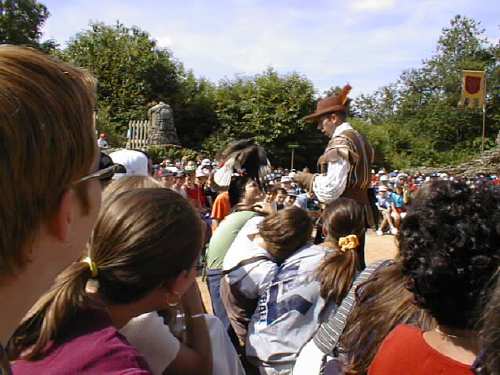
Among the ages represented at Le Puy are the years around 1000 AD (the low
Middle Ages), then the high Middle Ages, the Renaissance (1500's), and the 18th century
when the Revolution was on the horizon. Below, are Mona Iskander, Jennifer Campbell,
and Betsy Goosman who pose before the "Fort of the Year 1000". As you see,
many structures in Europe at that time were made of wood. Permanent stone
settlements were not long in coming, however, and the high Middle Ages would soon perfect
the use of "permanent" materials to build its castles, churches, and cathedrals.
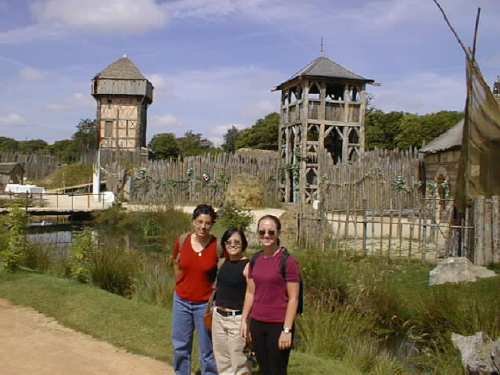
Saint Philibert is a familiar name to all inhabitants of Vendée. He was
one of the evangelists who worked to Christianize this pagan country back in the
700's. After his death, his remains were first buried in the church near the castle
of Noirmoutier, which we visited during our first week in Vendée. Le Puy thus
offers a spectacle in honor this saint, whose remains were threatened by the marauding
Vikings in the 900's. All the actors here are volonteers from the
community. They thus do not hesitate to ask for a little help from their
guests. Below, Julian Brayman is interviewed by one of the actresses and invited to
join the troupe for today's play.
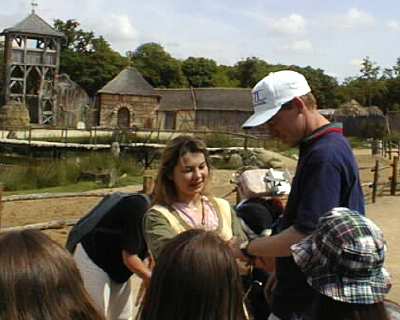
Dr. M. Lastinger (yours truly) will also be selected to participate in the
play. Below, Julian and I play happy peasants at the marriage of our noble
protectors. This bucolic scene is soon to be interrupted by the sound of the alarm
announcing the arrival of savage barbarian Vikings who desend on our peaceful shores from
the frozen lands of the North.
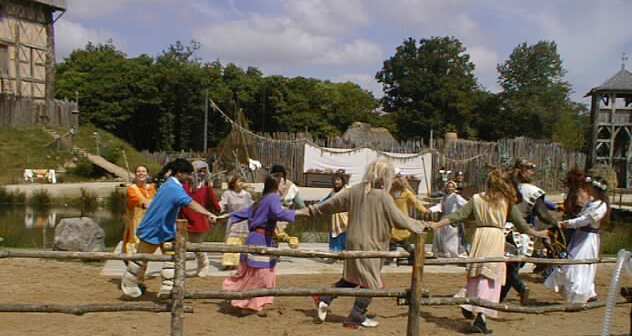
The dreaded "drakkars" (Viking long boats) arrive and the holy remains
of our precious Saint Philibert will be moved further and further inland to protect his
relics from the pagans. Finally, the spirit of Philibert will rise from the waters
and the Vikings will be converted to the true faith of the land. Also pressed into
service as Viking invaders, Julian and I struggled holding up those heavy swords, shields
and axes when we also played the roles of the marauders. None were more happy than
we to lay down our arms and kneel before our beloved Philibert.
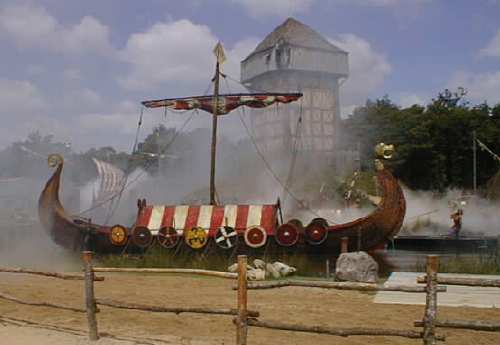
The art of the horse ("le cheval") was among the most prized skills
of the Frankish warriors who invaded the Gaul of the Roman Empire and changed the name of
the land in their own honor. Thus Roman "Gaul" became Frankish
"France". The mastery of the horse, the full implementation of the stirrup
(which allowed them to stay mounted even under the most ferocious of attacks), and the
metallurgy that allowed the production of durable weapons and armor soon became the
foundation of a new order on this territory. Below, Le Puy reproduces a joust in
which noble knights test their skills in friendly competion. Lovers of French
history know that it was in just such a test that the great king Henri II was killed in
1559. Henri II's death at a moment when passions and hatreds between Catholics and
Protestants were at a peak would open up one of the most violent periods of French
history: the Wars of Religion. The joust below is in the style of Henri II's
father, François I who is cherished by all France as the father of their
Renaissance. Next week we will visit the valley of the Loire and the Renaissance
châteaux where both François I and his son Henri II spent many of their best years.
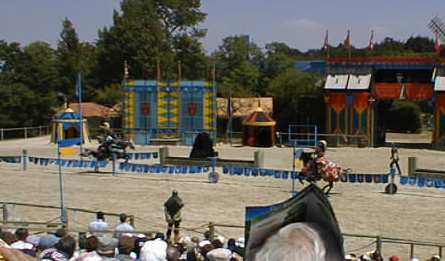
Animals were also a part of daily life up until the most recent of
times. As Allison Lastinger, Mona Iskander, and Megan Sadler demonstrate
below, the donkey was among the most amicable of beasts.
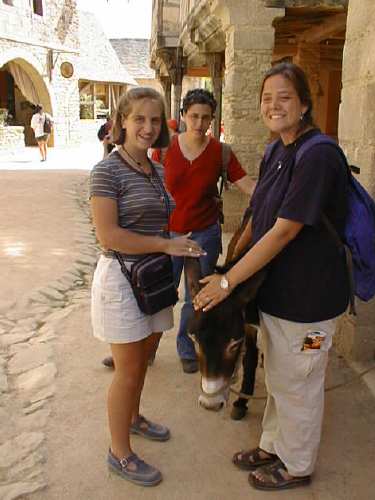
Our lunch in the Medieval village seemed a thousand years in the coming, but we
are all otherwise very pleased with the authenticity of the setting.
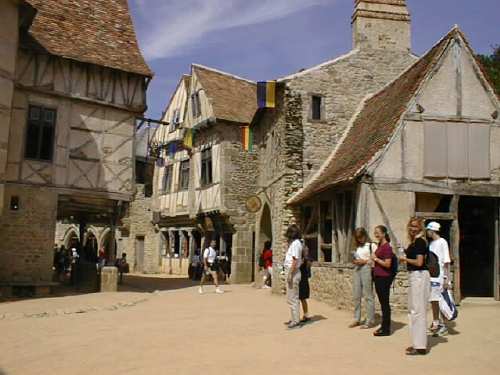
The industrial revolution was late in coming to France. One can
understand the reluctance to convert to mass production when the work of artisans is so
highly prized. A great number of traditional skill trades are represented at Le
Puy. Below, Betsy Goosman, Christin Cox, Kristi Widlak, along with the
"Yankee" Alexander Lastinger and his cousin Romain Crêtaux, look on as a
"sabotier" makes "sabots"or wooden shoes, the traditional shoe of the
French peasant. I believe I've already mentioned that the shoe was also a favorite
peasant weapon. In the face of perceived injustice, the peasant would throw his
"sabots" into the mills and other machines of his oppressors... Thus the origin
of the word "sabotage"...
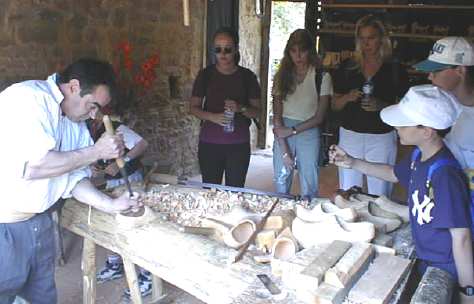
Stay tuned to WVU-V!
Go on to June 24, 1998.












